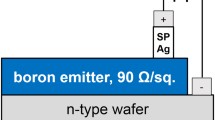Abstract
The SEM and specific contact resistance measurements of the Ag metal contact formed by applying a fire-through process on the shallow emitter region of the silicon solar cell have been investigated. The metal contact consists of screen-printed Ag paste patterned on the silicon nitride (Si3N4) deposited over the n+-Si emitter region of the solar cell. The sintering step consists of a rapid firing step at 800 °C or above in air ambient. This is followed by an annealing step at 450 °C in nitrogen ambient. It enables to drive the Ag metal paste onto the Si3N4 layer and facilitates the formation of an Ag metal/p-Si contact structure. It serves as the top metallization for the screen-printed silicon solar cell. The SEM measurement shows that sintering of the Ag metal paste at 800 °C or above causes the Ag metal to firmly coalesce with the underlying n+-Si surface. A thin layer of conductive glassy layer is also presents at the interface of the Ag metal and n+-Si surface. The electrical quality of the contact structure was characterized by measuring the specific contact resistance, ρ c (in Ω-cm2) using the iteration technique based on the power loss calculation for the solar cell. It shows that best value of ρ c = 2.53 × 10−5 Ω-cm2 is estimated for the Ag metal contact sintered at temperature above 800 °C. This value of ρ c is two orders of magnitude lower than the typical value of ρ c = 3 × 10−3 Ω-cm2 reported previously for the Ag contacts of the solar cell. Such low value of ρ c for the Ag metal contacts indicates that fire-through process results in excellent ohmic properties. The plot of the ρ c versus impurity doping level (N s ) shows that measured value of the ρ c follows a linear relationship with the N s as predicted by the theory for the heavily doped semiconductor surface. Hence, carrier injection across the Schottky barrier height is quite appropriate to explain the observed ohmic properties of the Ag metal contacts on the n+-Si surface of the silicon solar cell.





Similar content being viewed by others
Notes
The high conductivity paths through the p–n junction are caused by excessive metal penetration due to the limited solubility of Ag in Si [10].
The total resistance measured consists of the resistance of interfacial resistance, the resistance of the diffused layer and the resistance of the metal layer of the contact metal.
References
M.M. Hilali, A. Rohatgi, S. Asher, IEEE Trans. Electron. Dev. ED-51(6), 948–956 (2004). doi:10.1109/TED.2004.828280
P.N. Vinod, J. Mater Sci. Mater. Electron. 18, 805–810 (2007). doi:10.1007/s10854-007-9210-z
D.K. Schroder, D.L. Meier, IEEE Trans. Electron. Dev. 31, 637–647 (1984). doi:10.1109/T-ED.1984.21583
G. Schubert, J. Horzel, F. Huster, P. Fath, Proceedings of 20th European Council Photovoltaic Solar Energy Conference (EC PVSEC), Barcelona, Spain, June 2005, pp. 934–938
G. Schubert, F. Huster, P. Fath, Sol. Energy Mater. Sol. Cells. 90, 3399–3406 (2006). doi:10.1016/j.solmat.2006.03.040
M.M. Hilali, M. Al-Jassim, B. To, H. Mountinho, A. Rohatgi, S. Asher, J. Electrochem. Soc. 152(10), G742–G749 (2005). doi:10.1149/1.2001507
C. Ballif, D.M. Huljic, G. Willeke, A. Hessler-Wyser, Appl. Phys. Lett. 82, 1878–1880 (2003). doi:10.1063/1.1562338
B. Thuillier, J.P. Boyeaux, A. Kaminski, A. Laugier, Mater. Sci. Eng. B B102, 58–62 (2003). doi:10.1016/S0921-5107(02)00627-X
E.A. Addo, S.J. Shah, R. Opila, A.M. Barnett, K. Allison, O.V. Sulima, J. Mater. Res. 19(4), 986–995 (2004). doi:10.1557/JMR.2004.0129
D.L. Meier, H.P. Davis, R.A. Garcia, J.A. Jessup, A.F. Carroll, Proceedings of 28th IEEE Photovoltaic Specialists Conference, 2000, pp. 69–74
R. Preu, E. Schneiderlochner, A. Grohe, C. Ballif, S.W. Glunz, R. Preu, G. Willeke, Proceedings of 29th IEEE Photovoltaic Specialists Conference (PVSC), May 2002, pp. 300–303
E. Schneiderlochner, A. Grohe, C. Ballif, S.W. Glunz, R. Preu, G. Willeke, Proceedings of 29th IEEE Photovoltaic Specialists Conference (PVSC), May 2002, pp. 300–303
P.N. Vinod, Semicond. Sci. Technol. 20, 966–971 (2005). doi:10.1088/0268-1242/20/9/014
J. Szlufcik, S. Sivoththaman, J.F. Nijs, R.P. Mertens, R. van Overstreaten, Proc. IEEE 85(5), 711–730 (1997). doi:10.1109/5.588971
S. Peters, J.Y. Lee, C. Ballif, D. Borchet, S.W. Glunz, W. Warta, W. Willeke, Proceedings of 29th IEEE Photovoltaic Specialists Conference (PVSC), 2002, pp. 214–217
R. Olesinski, A. Gokhale, G. Abbaschian, Bull. Alloy Phase Diagr. 10, 635–640 (1989). doi:10.1007/BF02877631
W. Kern, D.A. Puotinen, RCA Rev. 31, 187–196 (1970)
P.K. Basu, S.K. Dhungel, K. Kim, K. Chakravarty, J. Yi, J. Korean, Phys. Soc. 46(5), 1237–1242 (2005)
P.N. Vinod, Ph.D Dissertation, University of Delhi, February 2003
P.N. Vinod, J. Mater. Sci. Mater. Electron. 19, 594–601 (2008). doi:10.1007/s10854-007-9395-1
Y.S. Chung, H.G. Kim, IEEE Trans. Components. Hybrids Manuf. Technol. 11(2), 195–199 (1988)
T. Nakajima, A. Kawakami, A. Tada, Int. J. Hybrid Microelectron. 6(1), 580–586 (1983)
D.R. Reimer, Proceedings of 13th IEEE Photovoltaic Specialists Conference (PVSC), 1978, pp. 603–613
S.P. Murarka, Silicides for VLSI Applications (Academic Press, NY, 1983)
J.D. Plummer, P.B. Griffin, Proc. IEEE 89(3), 240–258 (2001). doi:10.1109/5.915373
S. Kontermann, G. Emmanuel, J. Benick, R. Preu, G. Willeke, Proceedings of 21st European Council Photovoltaic Solar Energy Conference, Dresden, Germany, 2006
S.M. Sze, Physics of the semiconductor device (Wiley, NY, 1982)
H.H. Berger, J. Electrochem. Soc. 119, 507–514 (1972). doi:10.1149/1.2404240
H.H. Berger, Solid State Electron. 15, 145–158 (1972)
G.K. Reeves, H.B. Harrison, IEEE Trans. Electron. Dev. Lett. EDL 3, 111–113 (1982)
S.J. Proctor, L.W. Lindholm, IEEE Trans. Electron. Dev. Lett. EDL-3, 294–296 (1982). doi:10.1109/EDL.1982.25574
C.Y. Chang, Y.K. Feng, S.M. Sze, Solid-State Electron. 14, 541–554 (1971). doi:10.1016/0038-1101(71)90129-8
C.M. Osborn, K.B. Bellur, Thin Solid Films 332, 428–436 (1998). doi:10.1016/S0040-6090(98)01046-3
A.C.Y. Yu, Solid State Electron. 13, 239–245 (1970)
F.A. Podovani, R. Stratton, Solid State Electron. 9, 965–976 (1966)
D.L. Meier, H.P. Davis, A. Shitibe, T. Abe, K. Kinoshita, Proceedings of 2nd World Conference on Photovolt Energy Conversion, Vienna, Austria, 1998, pp. 1491–1494
Author information
Authors and Affiliations
Corresponding author
Rights and permissions
About this article
Cite this article
Vinod, P.N. SEM and specific contact resistance analysis of screen-printed Ag contacts formed by fire-through process on the shallow emitters of silicon solar cell. J Mater Sci: Mater Electron 20, 1026–1032 (2009). https://doi.org/10.1007/s10854-008-9815-x
Received:
Accepted:
Published:
Issue Date:
DOI: https://doi.org/10.1007/s10854-008-9815-x




